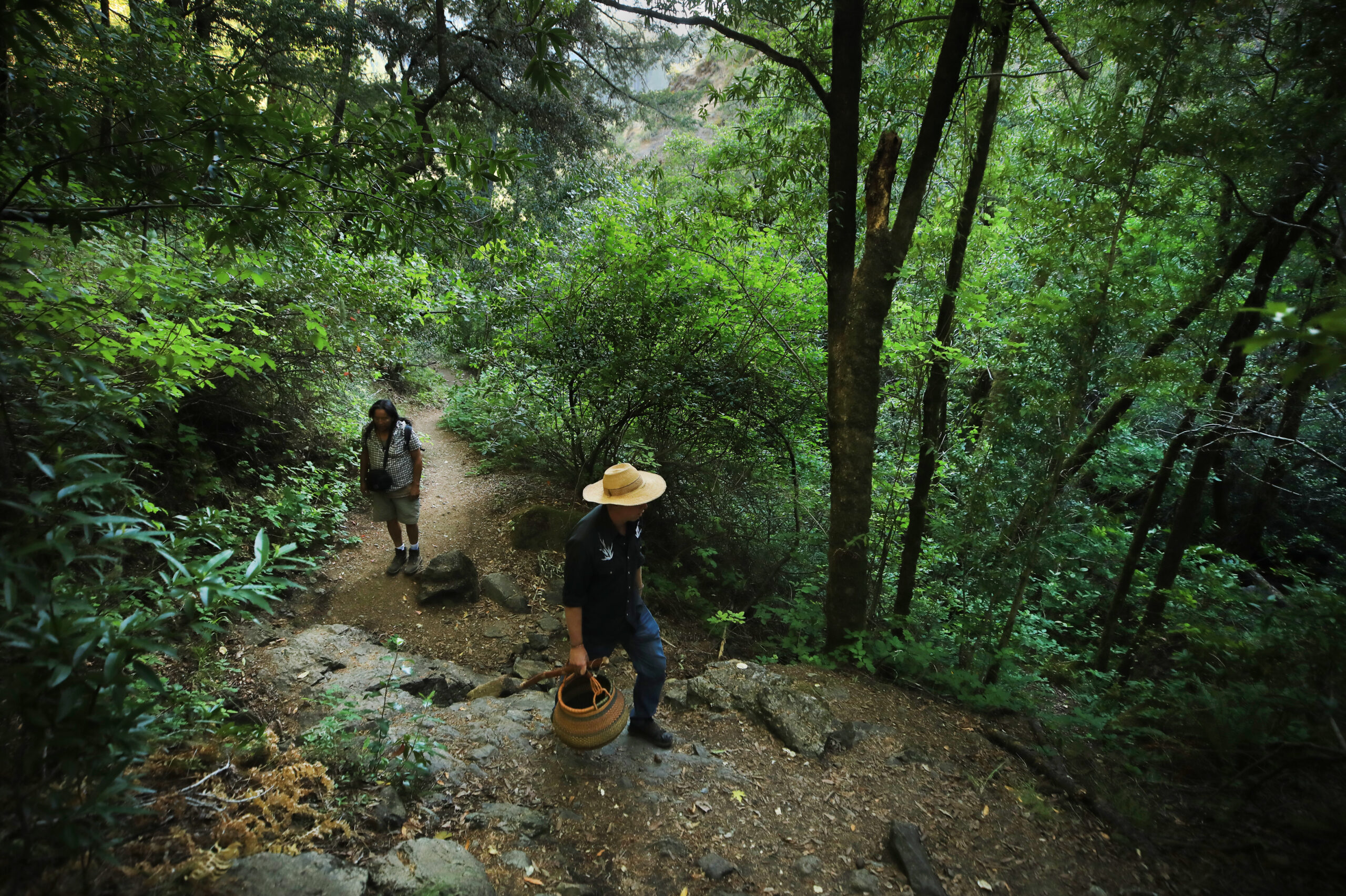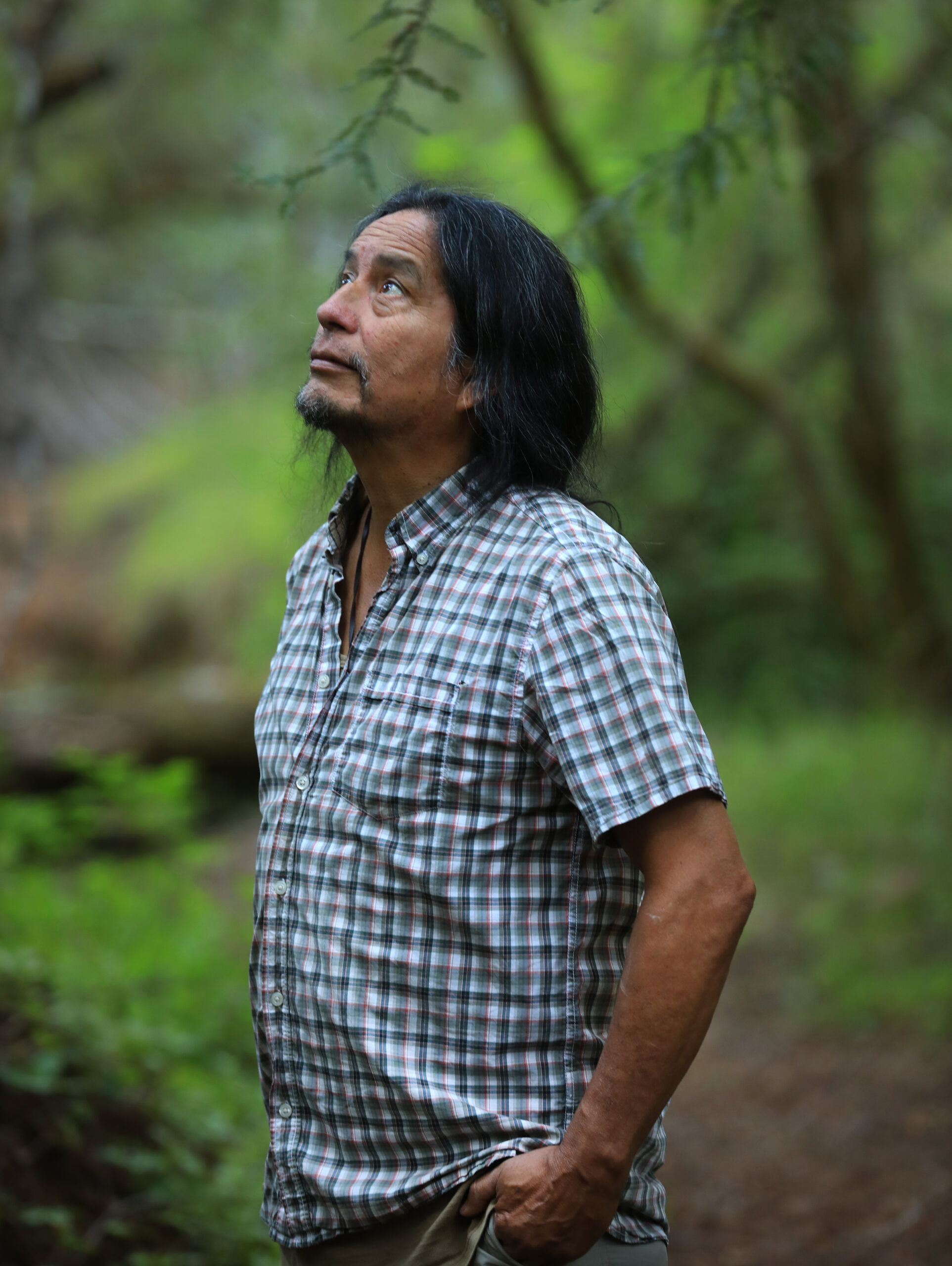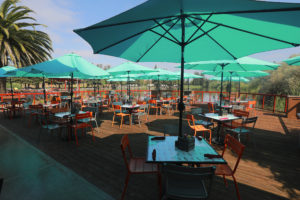It doesn’t take long into a foraging expedition for Ryath Beauchene to share one of his biggest pet peeves: “I try not to say the word ‘foray,’ as in ‘going on a mushroom foray,’” he explains. “If you look up the definition, it’s a military incursion into enemy territory,” he says, as he drives north along Highway 1 to Salt Point State Park, a stuffed toy mushroom swinging back and forth from his rearview mirror.
Before long, Beauchene is standing in the middle of the forest, savoring a lull between winter storms. It hardly feels like a military invasion. Bird calls are blanketed by the sound of crashing waves in the distance. Hiking through mossy ravines, over and under fallen logs, he picks candy caps and chanterelles that pop bright yellow and orange against the forest floor, much less camouflaged than the black trumpets hiding in patches.
“These are my friends,” Beauchene says, showing off his harvest with outstretched mycelium-tattooed arms. As a longtime mushroomer and co-owner of Moon Fruit Mushroom Farm near Sebastopol, he can see why people call the search for these small treasures “Easter egg hunting for adults.”
But, depending on who you ask these days, the original, warmongering intention of foray might feel a little closer to the truth. Google “mushroom foray” and you’ll get nearly half a million hits. In our region, the seasonal mad dash for prized porcinis and other mushrooms has become so competitive that Salt Point State Park administrators recently dropped the “bag limit,” indicating how many mushrooms a visitor can collect each day, from 5 pounds to 2 pounds.
“I do the best I can,” says park ranger Levi Pior, who carries a digital hanging scale everywhere he goes. In just his second year on the job, Pior is the lone enforcer of the newly lowered limits, which went into effect at the start of the new year. “I’ve caught a few people —one had 37 pounds of porcini. And I’ve seen photos of people taking 40 to 50 pounds of matsutake out of the park.”
“These are commercial people and families that are coming in, and they’re trying to loophole the rule. They’re coming in with five or six people and now they can take 25 to 30 pounds and now they’re taking this to a farmers market and making a commission on the state, which isn’t fair to the rest of the public who are just coming out to learn and forage and find stuff for food and just get out in nature and enjoy it. They’re making it a business.”


It’s not just mushroomers who are facing stiff competition. Whether harvesting seaweed in lowtide pools, gathering green herbs in the woods, or collecting wildflowers in roadside gullies, foragers up and down the North Coast are facing increased pressure in the wild.
“Since COVID, the secret places where nobody would ever be, there are people there now,” says Redbird Willie, a local Indigenous ecologist of Pomo, Paiute, Wintu and Wailaki ancestry. He lives on the 7.6-acre Heron Shadow Farm in Sebastopol, where he and other tribal members reconnect with the land, gathering wild foods for cultural ceremonies and growing traditional crops like squash, corn, elk clover, and ginseng. Away from the farm, Redbird Willie regularly forages on lands throughout the Bay Area.
“You would think after shelter-in-place ended, it would settle down,” he says. “But it hasn’t. People learned about these places, and now they use them.” He first began harvesting from wild spaces years ago, when he set out to learn Pomo basket weaving with his daughters. It’s customary, he says, to take time and learn the deep-rooted story of the habitat that you hope to harvest. “My practice is if I find a patch, I don’t harvest from it for a year. I’ll observe it for a year before I start interacting with it, just to decide how resilient and how healthy it is.”
Unfortunately, others don’t always practice the same level of respect and reciprocity when it comes to leaving enough for others. He recently returned to a patch of dogbane he had been tending for years, harvesting small amounts to use in making rope, only to discover that somebody had clear-cut the entire area.
“Usually, Native people can spot an area that’s being tended,” he says. “If you’re out and doing it all the time, it’s easy to tell. But if you’re inexperienced, and you come across this big, healthy patch, it’s pretty tempting I guess.”


When Heidi Herrmann founded Strong Arm Farm and began harvesting nori and kombu seaweeds along the Sonoma Coast 15 years ago, she contacted several sea farmers along the Mendocino Coast, where competition for seaweed can be much more fierce.
“I reached out and said, ‘Can I come see your drying techniques?’ and nobody invited me,” she remembers. “I was all peppy and optimistic, and it wasn’t met with meanness, but more like, ‘I don’t have time for that.’” Learning by talking to biologists and reading everything she could get her hands on, Herrmann quickly found that June and July were the best months with the lowest tides and the most sunshine. But it was common sense that led her to the basic rule of foraging: “Don’t pillage.” It’s the same rule she applies to her cut-flower business, where she’ll stop alongside the road and pick up bamboo or eucalyptus or redwood branches to make wreaths and garlands. Some people call it “scrumping,” she says, adding that a mossy log can fetch $12 or more for use as a tablescape.
The basic foraging rule of thumb, Herrmann explains, is to take only a tenth of what is growing and leave plenty for others, which includes humans and animals. But it’s not a foolproof rule, she explains. “What if 10 people come after me and they’re all taking 10 %?”
Early on, it was important to learn how to cut the seaweed, trimming kombu where it starts dividing into fingers, so it grows back abundantly. “It truly feels like a regenerative food,” she says. “I could conceivably harvest a second time off this crop. You can’t say that about much.”
Recreational seaweed harvesters are allowed to take home 10 pounds per day. Because she holds a commercial permit, Herrmann is able to harvest around 2,500 pounds a year, which supplies restaurants, stores, catering outfits and even local nonprofits like the Ceres Community Project in Sebastopol, where chef John Littlewood uses her foraged kombu in medicinal broths.
When she started teaching classes and leading seaweed harvesting tours for ForageSF, people joked that she was giving away her secrets to future business competitors. “But once people realize it’s going to take you all day to process this little 10-pound bag, most people would rather keep their day job,” she says.

Herrmann is also careful not to reveal too much to her students. “I’m not going to share my secret spots,” she says. “It’s just like mushrooming—find your own secret spot.” Like most experienced foragers, Herr≠≠mann sees education as the key to raising awareness and showing eager newbies how to forage mindfully.
Barbara Jean Avery, a friend of Herrmann’s, once harvested nettles and other wild herbs and sold them to restaurants like the Farmhouse Inn and Backyard. But it didn’t take long for her to see how foraging for money could be a conflict. Now, as director of the S onoma County Herb Exchange, Avery promotes the growing of herbs instead of foraging and other wild crafts.
“I think the relationship between wildcrafting and commerce is sketchy at best,” she says. She says she’s seen plants like wild sage decimated by foragers.
“I think we live in a culture of extraction and privilege, and we’ve been taught that everything is there for the taking and that’s just not true,” she says.
Avery tries to change mindsets, overseeing programming for the Sonoma County Herb Exchange’s education programs. She likes to tell first-time foragers that it can be the journey and not the “take” that provides the most benefit. “I think one can go out and be among the plants, and that can be the medicine,” she says. “You don’t necessarily need to take something home and put it in a cup of tea.” Then again, it can depend on the plant. In her mind, if somebody wants to forage for fennel, which she says is highly invasive, then have at it.
Near the top of the list on the unspoken foraging code of ethics is: Don’t pick a plant or mushroom and then discard it because you decide you no longer want it or need it or like it. A day before our trip to Salt Point, Beauchene warned how “people leave unwanted mushrooms all around – you’ll see them littering the forest floor.” Ranger Levi Pior mentioned something similar. “If you don’t know what the mushroom is, take a photo of it,” he recommends. “There are great apps out there like iNaturalist. But you shouldn’t take it and then just flip it on the ground and leave it upside down. It’s kind of taking away from someone else enjoying it.”
And sure enough, as he searches for a psilocybe mushroom recently spotted near Gerstle Cove campground, Beauchene finds a discarded red russula mushroom sitting on top of a bear box. “Why do people do this? This happens all the time,” he says, visibly frustrated. “This is living tissue that could be inoculating the forest.”
He digs a shallow hole and buries the russula near some pine trees to help cultivate future mushrooms, a process he terms “field propagation” or “ecological participation.” Scenes such as this are part of the reason he and his partner started leading mushrooming walks at Salt Point. “We were resisting that for many years because we didn’t want to add to the traffic in that park. But we’re not seeing the practices change, and we feel we have a lot to share.”

Last summer, chef Daniel Kedan, who teaches at the Culinary Institute of America in Napa, took his “Farm to Table” class on a field trip to learn how to harvest seaweed along the coast with Herrmann. He wants his students to understand the impact they have as chefs. “We’re the ones that are buying, and so every single thing that we do, we’re putting our money where our mouths are,” he explains. “I could buy something off the back of the truck just as easily and probably make more of a profit that way, but that’s not what it’s about.”
Years ago, it was a roaming band of foragers who opened Kedan’s eyes to the possibilities of working with wild foods in his restaurant: a species of fiddlehead with marzipan flavors or a wild watercress unlike anything he’d ever tasted. “We used to get these wild onions,” he remembers. “Now I see them everywhere, but until someone brought them in, I’d never known.” When Kedan’s Forestville restaurant, Backyard, closed in 2021, it was a loss not only for customers, but also for foragers from around the North Bay who would show up at the back door of the kitchen and unload their wild-picked bounty.
One of his most reliable mushroom sources was Dylan Taube, who first started supplying Kedan with fungi when Kedan was the executive chef at Lowell’s in Sebastopol. Over the past decade, Taube has traveled the mushroom circuit all over California, and as far north and west as Washington and New Mexico. Taube says he’s picked over a thousand dollars’ worth of mushrooms in a day, but other times comes home empty-handed.
As soon as he gathers a good batch, he’ ll start texting Sebastopol and Petaluma chefs to see who’s interested. Prices vary with supply and demand, but he can sell chanterelles and hedgehogs for around $15-$17 a pound. Porcinis can go for $20-$25 a pound. Loyal restaurant clients include Ramen Gaijin, Fern Bar, Handline, Cucina Paradiso, Central Market and The Sea Ranch Lodge.
Since the pandemic, he’s seen mushrooming become super-trendy. “You’ve got people from the Bay Area driving up in their Teslas, saying, ‘I want to learn about mushrooms.’ Cool, that’s great, bro. But you’ve got people who are trying to survive. And you’ve got a valuable commodity that’s like dollar bills sitting on the forest floor. What would you do? If you have $1 bills and $5 dollar bills sitting all over the forest floor – are you gonna grab them or are you gonna leave them?”
He has a commercial permit to harvest in Jackson Demonstration State Forest in Mendocino County, where he often hunts. Salt Point can be good, but he agrees with mushroom elder Patrick Hamilton, aka the MycoChef, who says the reason Salt Point is so over-run with visitors is “because it’s the only game in town” – the result of being the only state park in California that allows mushrooming.
“If you drive up to Salt Point along Highway 1 during porcini season (roughly 10 days after the first rain in the fall), you can barely park a car now,” says Hamilton, a Sonoma County Mycological Association board member and avid mushroom hunter for more than three decades. Like many, he believes opening other state parks would relieve pressure on Salt Point. Over a decade ago, he lobbied Golden Gate National Recreation Area administrators to open their land to mushrooming, but they refused. As a result, as public lands grow more and more over-picked, private ranches and pastures are quickly becoming the final frontier.
“If you can make connections with people on private property, it can be a honey hole,” Taube says. He has friends who will occasionally hop a fence and poach on private property, but that can get dicey. “For me, it’s not worth getting arrested, and you can get shot at, you can get dogs sicced on you. It’s not worth it.”

Redbird Willie has run into similar problems over the years—an irony not lost on him as he tries to navigate what was once his native land.
“A lot of times, the places I go are not exactly legal,” he says. “It’s just a big issue for us—land access. So you have to be careful about that.”
“For Native people, that’s one of the things we always talk about—where can we go for this and that? And there are varying degrees of danger involved with all the different places, and you try to find the places that are the most forgiving.”
He’s noticed since he started collecting in the ‘90s, some national parks “have been more forgiving to native people to come and collect and do their cultural practices.”
On one trip, he was stopped by a national park ranger who took a quick look at his backseat filled with plants and said, “OK, move along.”
“Nowadays, there’s a path Native people can follow and ask permission,” he says. “Most rangers realize it’s a beneficial process. When a Native person tends to the land, they make it better. The biggest hurdle is bureaucratic red tape and how to get around that.”
In 2015, the Kashia Band of Pomo Indians, with the help of the Trust for Public Land, bought 688 acres on the northern Sonoma County coast, north of Salt Point and created the Kashia Coastal Reserve. One of the goals is to revive cultural traditions and the harvesting of Native foods—wild herbs, abalone, seaweed, mussels and urchins—on the land for many generations to come.
In her seaweed classes, Herrmann often teaches students how to show appreciation, leading them in a moment of thanksgiving for the source of the seaweed they’ve harvested and that will nourish them. She often prefaces it with “Hey, I know I’m appropriating this technique that the Pomo do, but I happen to like it.”
It’s a tricky balance between honoring a tradition and appropriating another culture, she explains, but she’d rather do it than nothing at all. “Here I am, just some like blue-eyed, blonde girl, like who am I? I’m just new here.”
Redbird Willie has seen Pomo customs like giving thanks coopted to the point where one can no longer tell their origin. And he admits it’s a fine line to parse. “I kind of lean in the direction where, if a person’s heart is in the right place, why bring it down if good things are happening from it?”
Back in the forest at Salt Point with Ryath Beauchene, it’s so quiet that when a waterlogged branch snaps and falls several stories to the earth, it sounds like the crack of a rifle. As he walks back to the car with several pounds of mushrooms he gathered in less than an hour, he says he’s come to recognize the park lands as, essentially, another home.
It’s exactly what Redbird Willie was talking about earlier that morning when he said, “People need to decide where their home is—where’s your home? When you say, ‘OK, this is my home,’ when they do that, then they’ll take responsibility for that spot. Then they care about where their water’s coming from. Then home isn’t just a little box that you sleep in.” Redbird Willie admits it’s a controversial view, the idea of conceding Native land as someone else’s home—a concept many of his friends don’t agree with.
Beauchene points out that it could work on another level as well: “If you’re in someone else’s home, you’re going to be much more respectful, right?”

Are More Regulations Coming?
Salt Point State Park ranger Levi Pior is a forager himself, hunting mushrooms regularly with his wife. One day, he would like to teach his 6-month-old daughter the hobby.
With new daily limits dropping from 5 pounds to 2 pounds, and the ever-growing popularity of foraging at the state park, Pior would like to see a permitting process implemented for mushroomers. “Almost like a fishing license,” he says. “Where you have to buy a permit or a mushroom foraging license for Salt Point. And then when you do that, we give you a list of rules or ethics.”
Wildlife ecologist Meghan Walla-Murphy had a similar idea of creating a foraging license that would be region-specific. For example, there might be different permits for coastal Sonoma County or the Mayacamas.
“Or it could be watershed-specific,” says Walla-Murphy, who teaches at Santa Rosa Junior College and leads the North Bay Bear Collaborative. “You would have a permit to harvest in this watershed because you’ve taken this class, but if you bump over into the Eel River watershed or into the Klamath watershed then your license no longer applies.”
Permits are already required to lead mushrooming group tours in Salt Point, so maybe individual foraging permits would not be that much of a stretch, says Pior. Afterall, permits are required to pick mushrooms in Jackson Demonstration State Forest further north in Mendocino County.
Even though state administrators have considered shutting down mushrooming all together at Salt Point, Pior says he can’t imagine a day when mushrooming is no longer allowed. “I’d like to see this park still open for foraging so my daughter can learn one day.”















